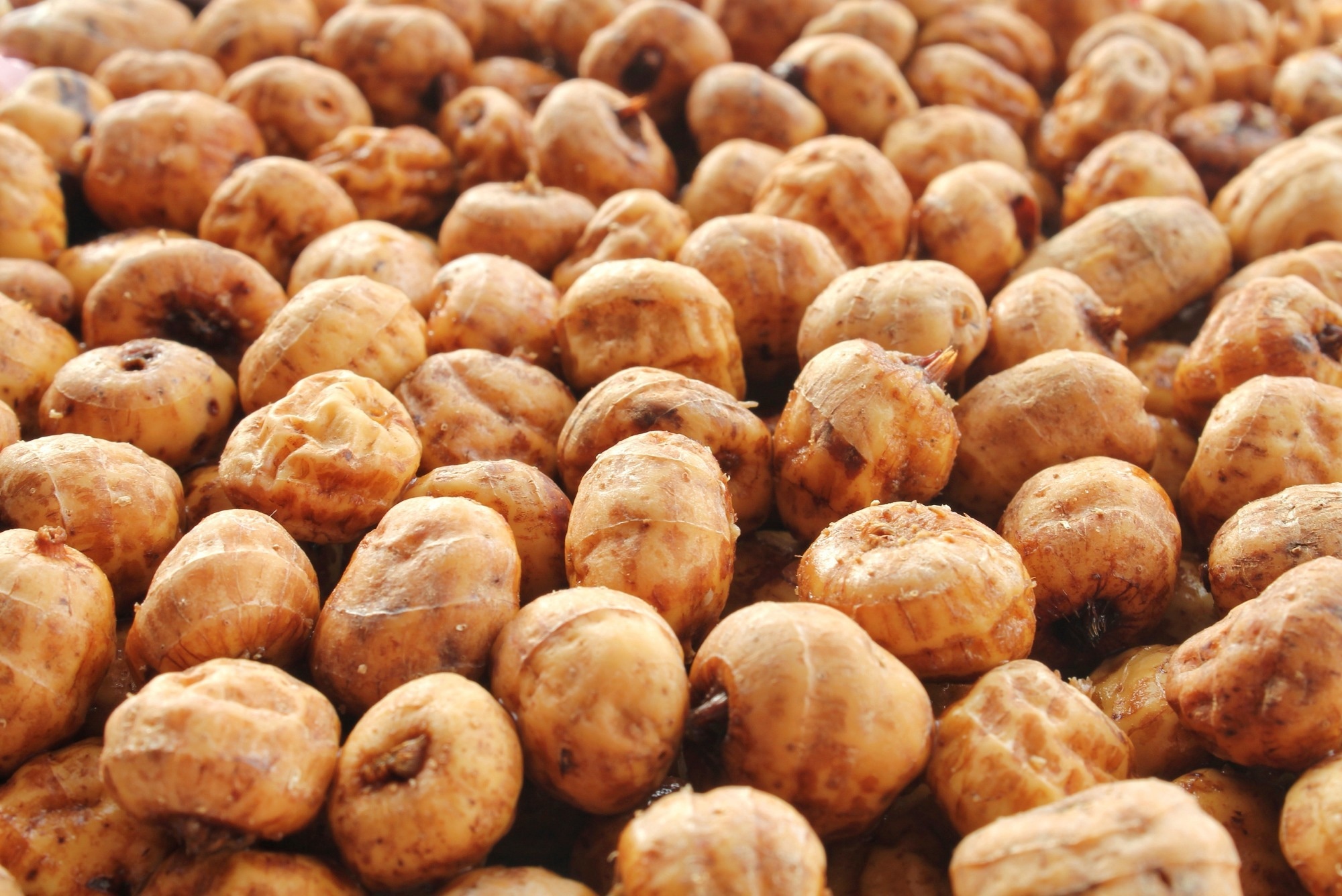Introduction
Global and historical uses
Nutritional composition of tiger nut
Digestive, cardiovascular, and metabolic health
Antioxidant and anti-inflammatory properties
Suitability for special diets and food sensitivities
Safety, storage, and consumption tips
Conclusions and future research directions
References
Further reading
Discover how tiger nuts, an ancient tuber once prized in Egypt, are gaining modern recognition for their role in gut health, cholesterol management, and sustainable nutrition.
 Tiger nuts. Image Credit: Lidia_Efimova / Shutterstock.com
Tiger nuts. Image Credit: Lidia_Efimova / Shutterstock.com
Introduction
As global consumer interest in plant-based dairy alternatives and functional foods increases, the tiger nut is being increasingly marketed and researched for its unique nutritional properties. This article discusses the unique nutritional profile of tiger nuts and their documented digestive, cardiovascular, metabolic, and microbiota-modulating benefits, while noting that most findings are preliminary or population-specific.1
Global and historical uses
Cyperus esculentus, which is more commonly referred to as ‘tiger nut’ or ‘chufa,’ is an edible tuber produced by Cyperaceae, a perennial plant from the sedge family. Originating in Northeast Africa and the Mediterranean, archaeological evidence suggests the earliest use and consumption of tiger nuts occurred in Egypt as early as 4000 B.C., where they were eaten roasted, ground into flour, or made into sweets.2
Since then, the cultivation of tiger nuts has spread across Africa, where they have remained a staple in Ghana and Nigeria for centuries. Historical records also highlight their medicinal use across Asia, with Cyperus species (including C. esculentus) being cited in traditional systems for the treatment of digestive and menstrual disorders.2
In Spain, particularly the Valencia region, tiger nut drink is prepared by soaking, grinding, and sweetening the tubers to obtain a creamy, milk-like liquid. Tiger nut drinks are often consumed as a refreshing summer beverage called ‘horchata de chufa.3
Nutritional composition of tiger nut
Tiger nuts are rich in lipids, which comprise 22–45% of their dry weight, followed by carbohydrates and protein at 23–48% and 3–9%, respectively. Tiger nuts are also rich in heart-healthy monounsaturated fatty acids, including oleic acid, which accounts for about 70–76% of fatty acids in tiger nut oil.1

The main nutritional composition and nutrient-based applications of tiger nut.1
Despite their moderate protein content, tiger nuts contain all essential amino acids in proportions that meet or exceed current recommendations from the World Health Organization (WHO).1
Tiger nuts also serve as a significant dietary source of dietary fiber (8–15% dry weight), resistant starch, potassium, phosphorus, and magnesium, as well as calcium and iron, alongside vitamins C and E and a variety of polyphenols and flavonoids.1,5
The high insoluble and resistant fiber content within tiger nuts passes through the small intestine undigested. As a result, tiger nuts are considered a prebiotic food source for beneficial bacteria in the large intestine, while also helping to alleviate constipation. A short clinical intervention with natural horchata confirmed selective enrichment of butyrate-producing bacteria.1,4,6
The cardiovascular health benefits associated with tiger nuts are attributed to the high concentration of monounsaturated fats. A 28-day intervention in hypercholesterolemic adults resulted in reductions in serum cholesterol, although hematological markers remained unaffected.7
Tiger nut consumption may also help maintain healthy blood sugar levels. In one human trial, acute consumption led to a statistically significant decrease in insulin levels, though blood glucose reduction was not significant, suggesting a possible improvement in insulin sensitivity.8
Genius Foods Author Max Lugavere On The Health Benefits Of Tiger Nuts
Antioxidant and anti-inflammatory properties
Tiger nuts are rich in vitamin E, polyphenols, and flavonoids, all of which protect cells from oxidative stress. These molecules target free radicals, which are unstable molecules implicated in the aging process and the development of chronic diseases.1,5
In vitro studies have demonstrated that tiger nut extracts exhibit antioxidant and lipid peroxidation–inhibiting activity, while oleic acid offers anti-inflammatory potential. To date, there have been no direct clinical studies on the anti-inflammatory effects of tiger nut consumption.1,5
Suitability for special diets and food sensitivities
As a tuber, tiger nuts are free from the most common allergens, including lactose, gluten, and tree nuts. However, rare cases of allergy have been reported, primarily associated with pollen-food syndrome in individuals who are sensitized. This unique, allergen-friendly profile makes tiger nut milk suitable for vegan, Paleo, and Autoimmune Protocol (AIP) diets that exclude grains, legumes, and dairy.1,4,9
The high fiber and resistant starch content, especially in raw whole tubers, slows digestion, prolongs fullness, and helps appetite control, thereby supporting weight management.4
Safety, storage, and consumption tips
Although tiger nut tubers can be stored hygienically for months, freshly prepared, unprocessed tiger nut milk is highly perishable due to its neutral pH and nutrient-rich composition. Consequently, commercial production relies on pasteurization or non-thermal technologies, such as high-pressure processing and pulsed electric fields, to ensure microbiological safety and preserve sensitive nutrients.3
The rising global popularity of tiger nuts is partly attributed to their versatility as an ingredient that can be enjoyed alone as a cold beverage or dairy-free alternative in smoothies, coffee, cereals, and a wide range of baking recipes. Standard serving sizes are about one cup daily, with the caloric content of commercial products ranging from 70–150 calories/serving.1,3,4
 Image Credit: Y.A. Photo / Shutterstock.com
Image Credit: Y.A. Photo / Shutterstock.com
Conclusions and future research directions
The current scientific literature promotes tiger nut products as nutrient-dense, functional foods with demonstrated prebiotic, cholesterol-lowering, and insulin-sensitizing properties. Nonetheless, the evidence base remains limited, with most studies being short-term, small-scale, or geographically restricted.
Future research should prioritize long-term clinical trials, dose-response studies, and evaluations across diverse populations to establish robust dietary recommendations.
References
- Yu, Y., Lu, X., Zhang, T., et al. (2022). Tiger Nut (Cyperus esculentus L.): Nutrition, Processing, Function and Applications. Foods 11(4); 601. DOI:10.3390/foods11040601, https://www.mdpi.com/2304-8158/11/4/601.
- Taheri, Y., Herrera-Bravo, J., Huala, L., et al. (2021). Cyperus spp.: A Review on Phytochemical Composition, Biological Activity, and Health‐Promoting Effects. Oxidative Medicine and Cellular Longevity (1). DOI:10.1155/2021/4014867, https://onlinelibrary.wiley.com/doi/10.1155/2021/4014867
- Roselló-Soto, E., Poojary, M. M., Barba, F. J., et al. (2018). Thermal and non-thermal preservation techniques of tiger nuts’ beverage “horchata de chufa”. Implications for food safety, nutritional and quality properties. Food Research International, 105, 945–951. DOI:10.1016/j.foodres.2017.12.014, https://www.sciencedirect.com/science/article/pii/S096399691730875X.
- Adejuyitan, J. A. (2011). Tigernut Processing: Its Food uses and Health Benefits. American Journal of Food Technology 6(3); 197-201. DOI:10.3923/ajft.2011.197.201, https://scialert.net/fulltext/?doi=ajft.2011.197.201
- Roselló-Soto, E., Poojary, M. M., Barba, F. J., et al. (2018). Tiger nut and its by-products valorization: From extraction of oil and valuable compounds to development of new healthy products. Innovative Food Science & Emerging Technologies 45; 306-312. DOI:10.1016/j.ifset.2017.11.016, https://www.sciencedirect.com/science/article/pii/S1466856417310585.
- Selma-Royo, M., García-Mantrana, I., Collado, M. C., & Perez-Martínez, G. (2022). Intake of Natural, Unprocessed Tiger Nuts (Cyperus esculentus L.) Drink Significantly Favors Intestinal Beneficial Bacteria in a Short Period of Time. Nutrients 14(9), 1709. DOI:10.3390/nu14091709, https://www.mdpi.com/2072-6643/14/9/1709
- Oguwike, F. N., Nwosu, P. N., Nwafor, C., et al. (2017). The effects of Cyperus esculentus (Tiger nut) on Haematological and Biochemical Profile of Male Hypercholesteremic Subjects in Uli, Anambra State Nigeria. Journal of the Medical Sciences 7(4); 036-041. DOI:10.15580/GJMS.2017.4.061717075, https://gjournals.org/GJMS/archive/vol-7-4-july-2017/oguwike-et-al.html.
- Edokpolor, I. N., Oshomoh, O. W., Okosun, H. B., et al. (2024). Impact of tigernuts on blood glucose and insulin levels in normal weight male humans. International Journal of Applied and Scientific Research 2(11); 52-61. DOI:10.59890/ijasr.v2i11.387, https://journal.multitechpublisher.com/index.php/ijasr/article/view/3104
- González-De-Olano, D., González-Mancebo, E., Mohedano-Vicente, E., et al. (2013). Pollen-food syndrome involving allergy to tiger nut. Journal of Investigational Allergology and Clinical Immunology 23(3); 197-198. DOI:10.18176/jiaci.0091, https://www.jiaci.org/summary/vol23-issue3-num986
Further Reading
Last Updated: Sep 2, 2025